The Legacy of American Eugenics
Nov 24, 2020
An expose on the relationship between Darwinism, Eugenics, and Planned Parenthood and their legacy today
Short History of Darwinism
Charles Darwin was one of the most important figures of modernity along with Friedrich Nietzsche, Karl Marx, and Sigmund Freud. Their ideas formed the intellectual and scientific foundation for many of the 20th century political movements including the many socialist movements (mainly Marx), as well as the reactionary fascist movements (Darwin and Nietzche). While it likely common knowledge that Nazism and racial eugenics were heavily inspired by Darwinian evolution being applied to humans, it is less widely known that once racial eugenics fell out of fashion post WW2 the same prominent eugenics advocates rebranded themselves as experts in ‘genetics’, genomics, or population genetics.
Darwin was supported by Thomas Henry Huxley, nicknamed Darwins Bulldog, and his close friend Sir Joseph Dalton Hooker. In the historic 1860 Oxford evolution debate, they defended the Darwinian theory of evolution against its detractors. They were also both members of the X-Club which dominated the Royal Society in the late 19th century with 3 consecutive presidents (Hooker, Spottiswoode, and Huxley from 1873-1885) being members of the X-Club. He was also supported by his half-cousin Francis Galton. The three names (Galton, Darwin, and Huxley) were extremely important in the eugenics movement in Britain.
In the era before Darwinism universities did not grant biology degrees, and most biologists were self-taught. Through the efforts of Thomas Henry Huxley, and the Royal Society biology soon established itself as a prestigious field, primarily utilizing comparative anatomy as the core of biology curriculums until the advent of more specialized fields of biology. Darwinism’s influence very quickly expanded to all areas of society, even outside of what we consider science today with significant consequences in philosophy, metaphysics, and theology.
Short History of the Origins of Eugenics
The two main works of Darwin are the On the Origin of Species written in 1859 and the Descent of Man written in 1871. Francis Galton and Ernst Haeckel, both famous eugenicists, were deeply influenced by Darwin and his works, and applied the theory of evolution and natural selection to the human race. It was Galton who coined the phrase ‘eugenics’ in 1883, one year after Charles Darwin’s death. Haeckel promoted Darwins work in Germany, paving the way for the atrocities to come. However, even before the popularization of the term, the seeds of eugenics had already been planted. As you can see in a paragraph from Chapter 5 of the Descent of Man Darwin shows contempt for the weak, the poor, and the mentally unfit and notes that their genetic pool is “highly injurious to the race of man”[1].
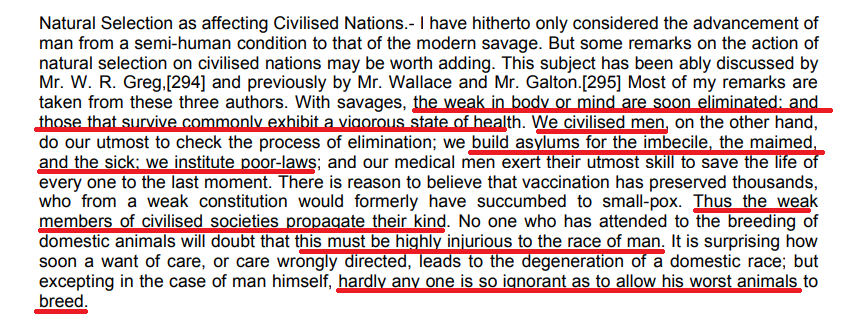
One often hears a white-washed biography which seeks to disconnect Darwin from the ugly legacy of eugenics, and to imply that it took seedy figures to twist it into genocidal policy. But this idea that one could improve the human race by preventing the ‘undesirables’ from reproducing was already present at least 30 years before the explosion societies promoting eugenics in the early 20th century. Darwin not only himself believed in some form of eugenics, he also endorsed Galton and Haeckel. In personal correspondence to Haeckel he says “I can clearly see that you are one of the few who clearly understand Natural Selection.”.[2]. Darwin writes enthusiastically to his cousin after reading Galton’s Heriditary Genius, which formed the basis of Galton’s later eugenic work and cited On the Origin of Species as a major influence the following.
“MY DEAR GALTON,–I have only read about 50 pages of your book (to Judges), but I must exhale myself, else something will go wrong in my inside. I do not think I ever in all my life read anything more interesting and original–and how Well and clearly you put every point!”. [3]
Not to mention that eugenics was propogated and legitimized by their descendants who made up the intellectual elite of the 20th century including Huxley’s grandson Julian Huxley, and many of Charles Darwin’s sons, and grandsons. Two of Darwin’s sons Leonard Darwin, and Sir George Howard Darwin [4] were champions of eugenics. Leonard Darwin even became chairman of the British Eugenis Society (BES) from 1911 to 1928, succeeding his relative Francis Galton. One of his grandsons, Charles Galton Darwin, was the BES president 1953-1959 and early 60s [5]. All were well respected members of the Royal Society.
How deeply did the theory of evolution penetrate the souls of these well-respected and richly adorned scientists? Galton believed that Darwin’s ideas would eventually evolve into a ‘eugenic religion’, designed to promote a genetically fitter human species, and wrote Kantsaywhere based on this. On a parallel track Julian Huxley, a famous eugenicist, who was president of the BES from 1959-1962, said this about eugenics [6].
“I find myself inevitably driven to use the language of religion, for the fact is that all this does add up to something in the nature of a religion: perhaps one might call it Evolutionary Humanism. The word “religion” is often used restrictively to mean belief in gods; but I am not using it in this sense….I am using it in a broader sense, to denote an overall relation between man and his destiny, and one involving his deepest feelings, including his sense of what is sacred. In this broad sense,evolutionary humanism, it seems to me, is capable of becoming the germ of a new religion, not necessarily supplanting existing religions but supplementing them.”
From this point on I am going to perform a network analysis, using Gephi, of major eugenics organizations, their funders, and founders. Then I will hone in on major centers and provide brief explanations of their importance.
Network Overview
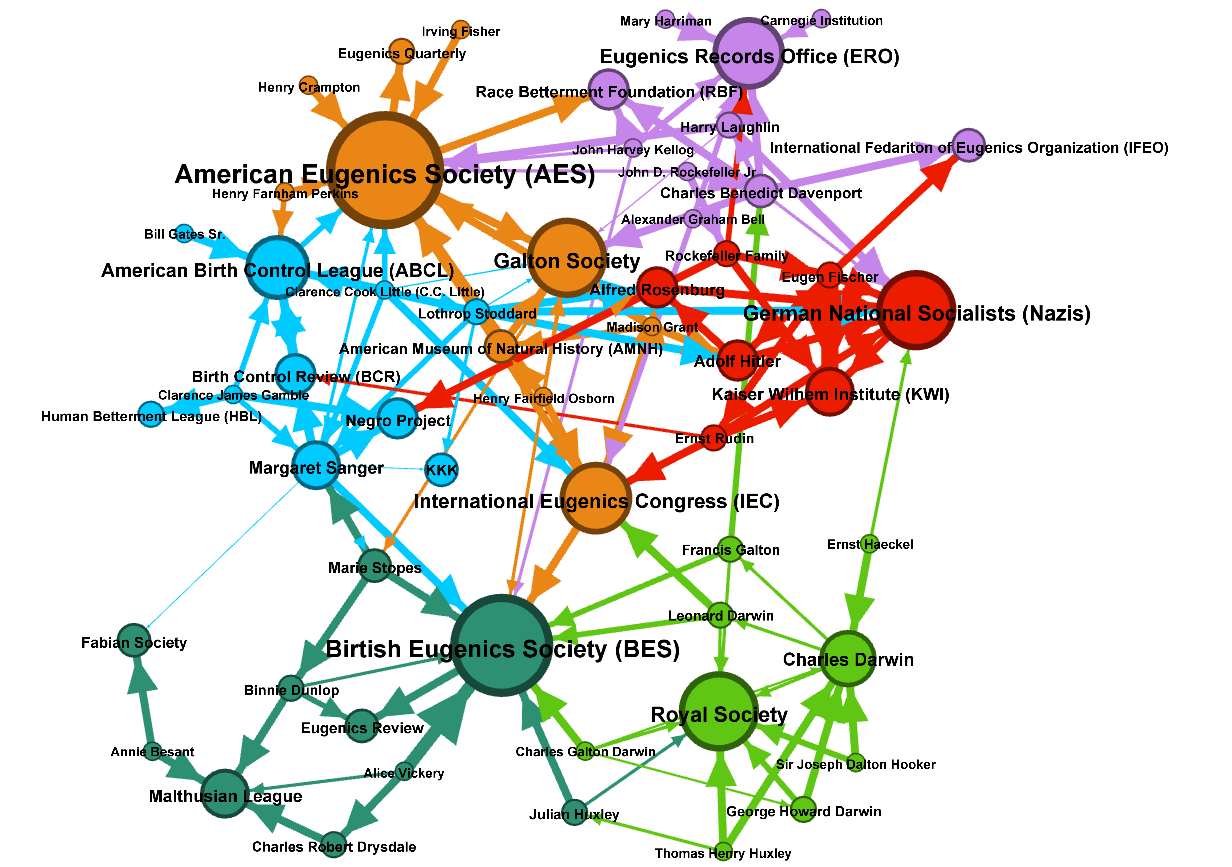
First thing to note is that several organizations have ‘rebranded here’, including American Birth Control League to Planned Parenthood in 1942, the American Eugenics Society to the Society for Biodemography and Social Biology in 1973, and the British Eugenics Society to the Galton Institute in 1989. Their journals have changed names as well; from the British the Eugenics Review to the Journal of Biosocial Science in 1969, and the American Eugenical News to Eugenics Quarterly in 1954, to Social Biology in 1969 Biodemography and Social Biology in 2008. This of course is a similar marketing tactic that the US Department of War had used when they changed their name to the Department of Defense in 1949.
The second thing to note is that this network is extremely complicated and I have provided the spreadsheet that I used to import into Gephi in my repository in case anybody wants it. I generally weight connections higher if an individual directly funds, or founds an organization, and if there are indications that an individual inspires another (as in the case of Madison Grant and Hitler). Lets dive into the key organizations and figures. There was an even bigger network that could have been explored via the BES’s and Fabian Society’s connections with occult and theosophy but I will leave that for another day.
Major Organizations of Eugenics
Eugenics Report office (ERO) at Cold Spring Harbor Labratory (CSHL)
The Eugenics Reports Office was a research institute founded in 1910 within the Cold Spring Harbor Laboratory under the Carnegie Institute of Washington Station for Experimental Evolution [7][8]. It was first funded by the Mrs. Mary Harriman (wife of railroad magnate E. H. Harriman), then by the Carnegie Institution in 1917, and later by John D. Rockefeller, John H. Kellogg, and other private wealthy philanthropists. Many of the people associated with the ERO were also founders or members of groups that promoted eugenics such as John Harvey Kellog (founding the Racial Betterment Foundation), and Harry Laughlin (founding the Pioneer Fund). It was Harry Laughin and the people financing him individuals that called 15 million Americans “defective”.
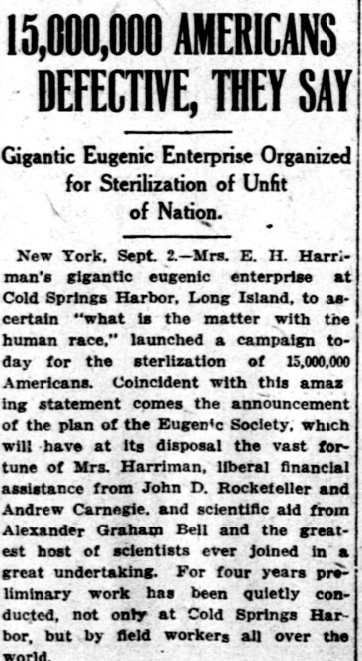
The two principal figures of the ERO are Charles Davenport, and Harry Laughlin, and hence are two very important figures in eugenics, and genetics in Davenport’s case. The ERO served as the scientific centre for researching eugenics and human heredity in America. Their activities included creating records hundreds of thousands of family pedigrees, offering courses to train eugenic field workers, and lobbying for mandated state sterilization. Research produced in the ERO was instrumental in the passage of numerous eugenic sterilization laws, including the statue that created the Oregon Board of Eugenics in 1917, and the Virginia Sterilization Law of 1924 upheld by the US Supreme Court Case Buck v. Bell (1927). [9] After the closure of the office, the CSHL continued to conduct research, and in the modern day is now one of the world’s leading institutions in neuroscience, cancer, quantitative biology, plant biology, and genomics.
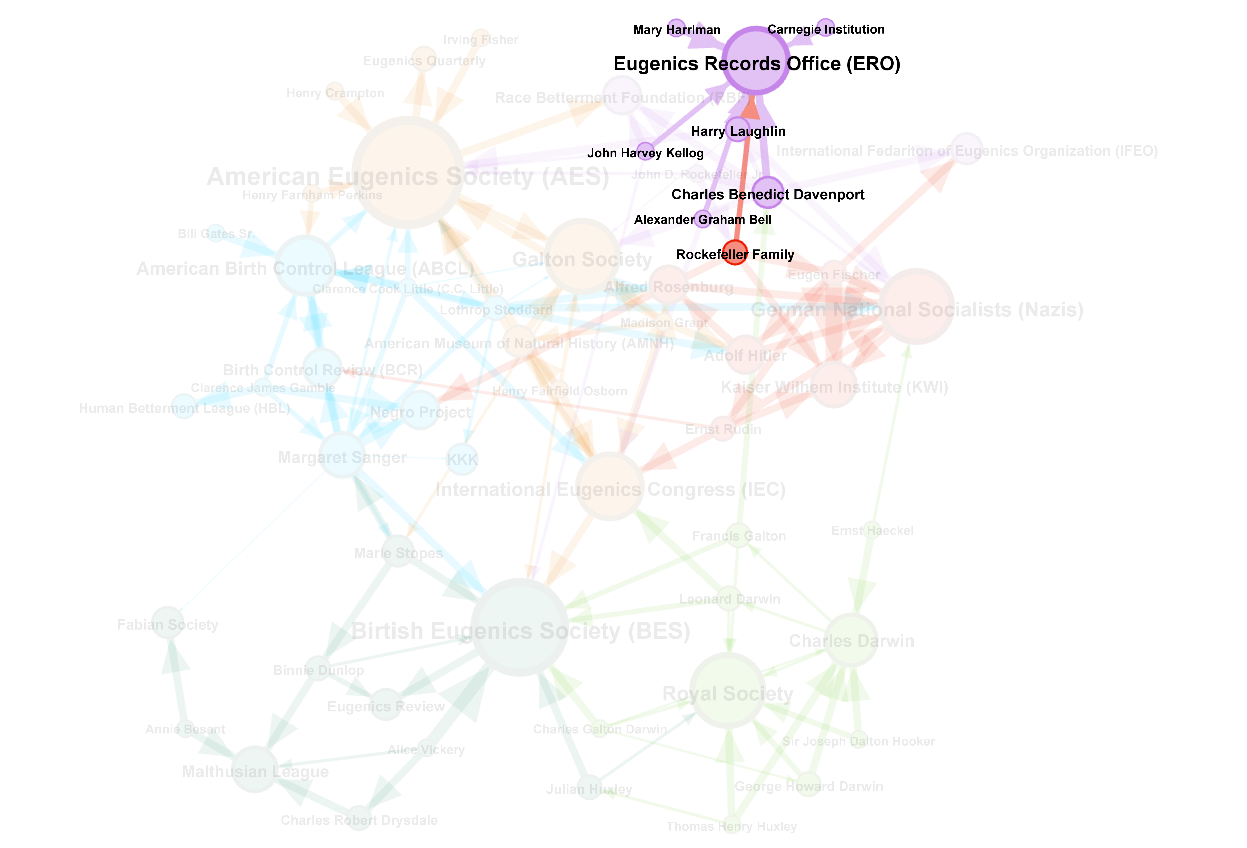
American Eugenics Society (AES)
The American Eugenics Society was formed in 1922 after the 2nd International Eugenics Congress (IEC in orange in the overview) by Madison Grant, Harry H. Laughlin, Irving Fisher, Henry Fairfield Osborn, and Henry Crampton [10]. Other prominent members and sponsors included Margaret Sanger, John D. Rockefeller, J.P. Morgan, C.C. Little, and Lothrop Stoddard. They promoted racial betterment, birth control, population control, racial hygiene, eugenic health, and eugenic education that led to government-enforced sterilizations (most notably Buck v. Bell) and anti-miscegenation laws. A secondary function was to organize and promote the work of smaller American eugenics organization like the Racial Betterment Foundation (RBF) and the Galton Society (GS).
There are several interesting connections… Henry F. Perkins, president of AES from 1931-1933, worked with Margaret Sanger and the American Birth Control League, the predecessor of Planned Parenthood. Several of their members such as Madison Grant, Lothrop Stoddard, and Davenport had ties to members of the Nazi party. The AES and the ERO paved the way for the eventual state enforce sterilizations of Native Americans[11], Puero-Ricans [12], African-Americans, all of whom constituted the lower classes of society. After eugenics fell from favor after WW2 their focus shifted to genetic analysis and human evolution. As stated in Network Overview the American Eugenics Society to the Society for Biodemography and Social Biology in 1973, though at their own admittance “The change of name of the Society does not coincide with any change of its interests or policies.”.
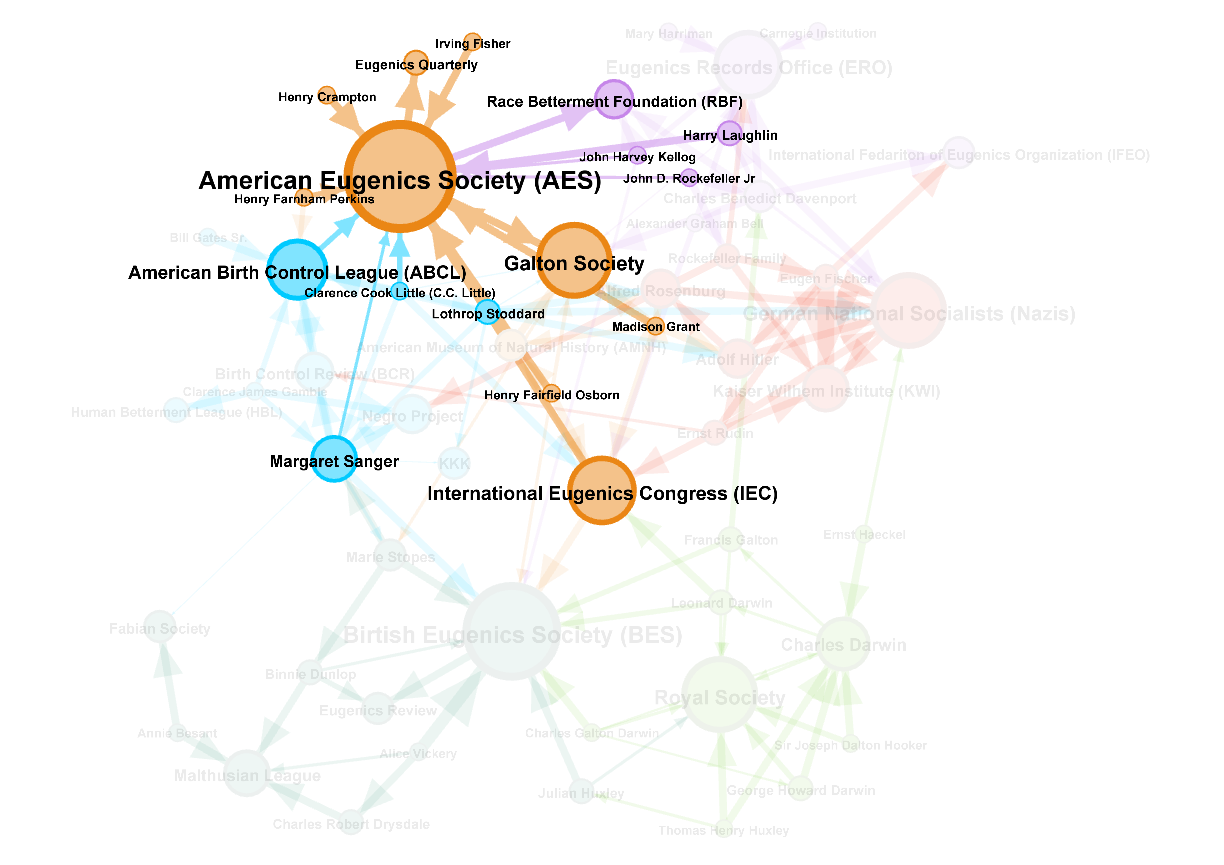
British Eugenics Society/Eugenics Education Society (BES) and Royal society
The British counterpart of the AES was the British Eugenics Society, also called the Eugenics Education Society. Prominent members included Marie Stopes, Julian Huxley, Charles Galton Darwin, Leonard Darwin, Francis Galton, Alice Vickery, John Maynard Keynes, Winston Churchill, and familiar American names like Margaret Sanger, Henry Fairfield Osborn, and John Harvey Kellog. The BES had its own publication called the Eugenics Review, and like the AES engaged in advocacy of eugenics through lobbying the Parliament, and “educating” the public through its publications and lectures. They had overlap with the Fabian Society and the Malthusian League both of which supported some degree of population control.
BES membership had a significant overlap with the Royal Society of the UK, the central hub of scientific research. Julian Huxley was a prominent member in both, and often used an agricultural analogy when describing eugenics “no one doubts the wisdom of managing the germ plasm of agricultural stocks, so why not apply the same concept to human stocks?”[13]. As stated in the section on the history of eugenics, the scientific milieu of the time saw eugenics as not only an attractive, but something that had to be put into practice for the improvement of the human race. There was a “greater good” that grounded the ideology of many of the members of the BES and the Royal Society. After eugenics as a term fell out of favor, the BES changed their publication name to the Journal of Biosocial Science in 1969 and their organization’s name to the Galton Institute in 1989.
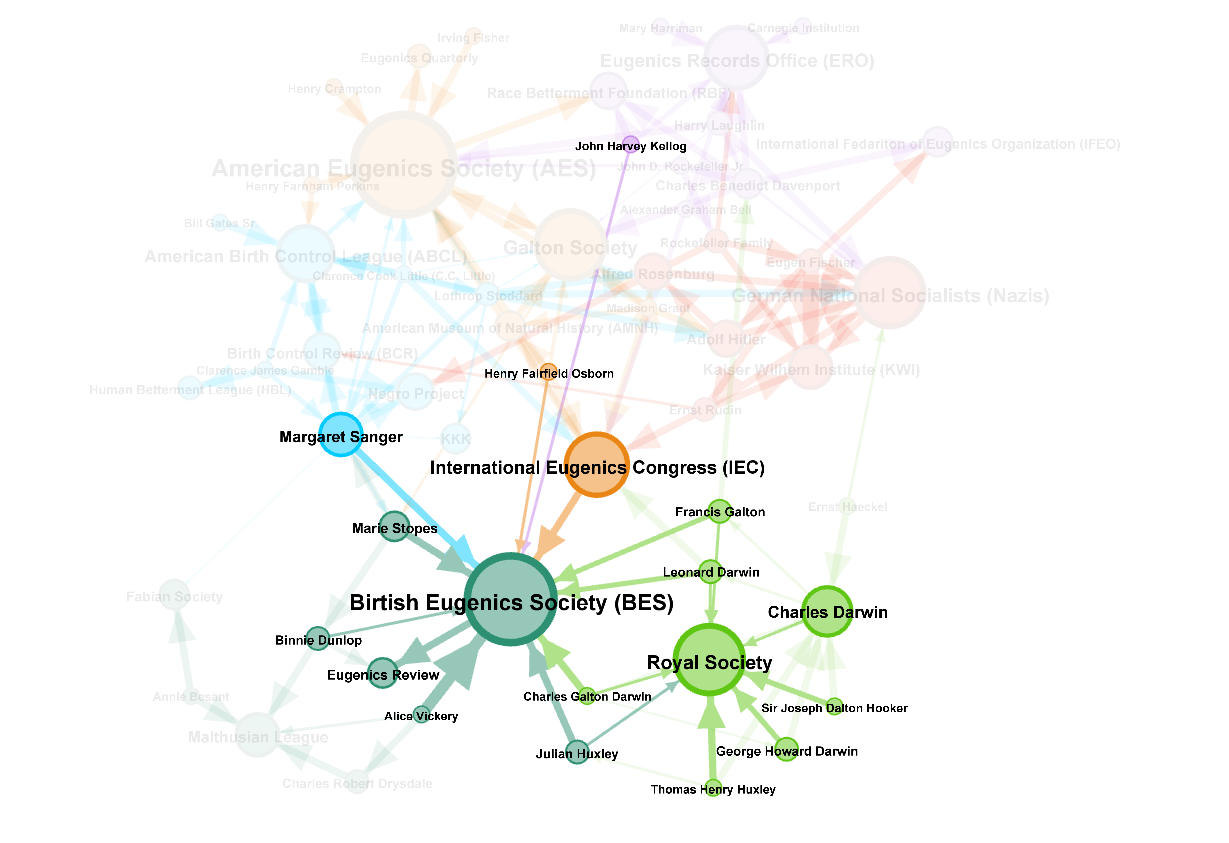
National Socialist Party of Germany (Nazis)
Obviously this group needs no introduction. But despite one’s familiarity it must be noted they have significant American connections. One can even say that at one point the Nazis looked to America for scientific and ideological guidance due to how highly developed eugenics research was in America. In the early 20th century, pre-Nazi Germany was eager to modernize their universities to compete in the international stage in science and research. They founded the Kaiser Wilhelm Institutes (KWI) in 1911, which began eugenics research in the mid-1920s with the establishment of The Kaiser Wilhelm Institute of Psychiatry and the Kaiser Wilhelm Institute for Anthropology, Human Genetics, and Eugenics. Researchers and leaders at these institutions were eager to imitate the theory of eugenics being put into practice in the United States. They were especially impressed with the judicial ruling in Buck v Bell (1927), which effectively endorsed eugenics legislation and led to the coercive sterilization of more than 60,000 Americans over the course of the 20th century.
When the Nazi regime came into power in the 30s it became increasingly apparent that they rooted their policy in primarily American based eugenics research and ideology. In 1933, the Reichstag of Nazi Germany passed the Law for the Prevention of Hereditarily Diseased Offspring in 1933, closely based on ERO co-founder Harry Laughlin’s statistical models. The other ERO co-founder, Charles Davenport, founded the International Federation of Eugenics Organizations (IFEO) with Eugen Fischer, a German Nazi whose ideas informed the Nuremburg Laws of 1935, and Hitler’s ideal of a “pure Aryan” race as described in Mein Kampf. Davenport maintained connections to Nazi party even in 30s with Hitler’s rise to power [14]. Madison Grant, author of The Passing of the Great Race, founding member of the AES and Galton Society, was written a ‘fan letter’ from Adolf Hitler, who called his book “my Bible” [15]. Lothrop Stoddard, founding member of the American Birth Control League with Margaret Sanger, wrote The Revolt Against Civilization: The Menace of the Under-man, which was used by Nazi Party’s chief eugenic theorist Alfred Rosenburg to coin the term Untermensch. Stoddard also spent 4 months between 1939 and 1940 in Nazi Germany as a journalist, and due to his views he received preferential treatment over other American journalists, meeting with Heinrich Himmler, Robert Ley and Fritz Sauckel, as well as a brief meeting with Hitler himself.
Ernst Haeckel, previously mentioned as a promoter of Darwinian theory in Germany, I have also included as a connection to the Nazi party due to his belief in social darwinism, and racial hygiene. He also believed that the mentally ill and congenitally ill should be killed for the betterment of society, which was later implemented by Nazis in the Aktion T4 forced euthanasia program. The last thing to note is that the German eugenics program, and later on the Nazi eugenics policies were not only intellectual and scientific offspring of Americans, but also heavily financed by American interests, specifically the Rockefeller Foundation (more on this later). [16]
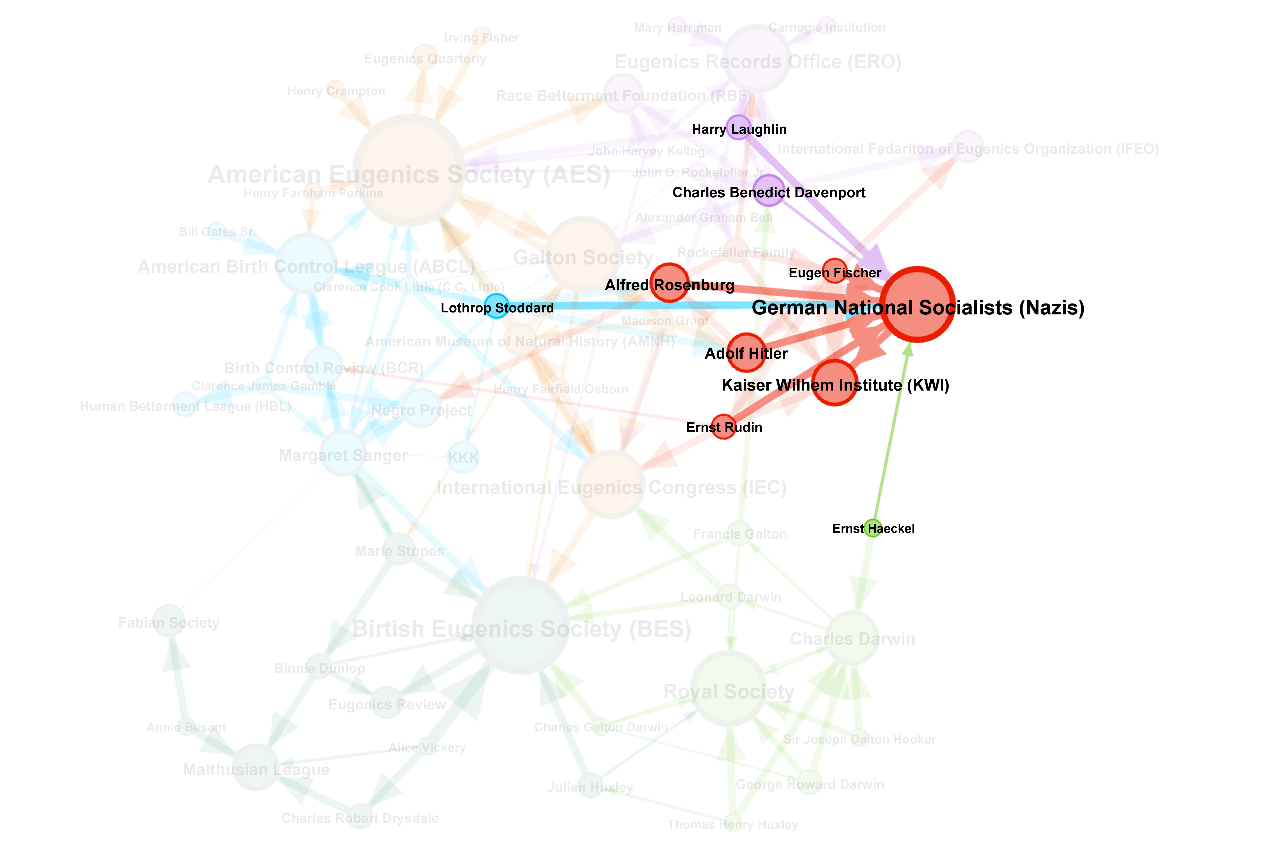
Margaret Sanger and American Birth Control League/Planned Parenthood (ABCL/PP)
Margaret Sanger is a modern day feminist icon due to the close and sometimes inseparable connection between women’s rights and access to birth control. Not often mentioned is her deeply held belief in eugenics and her association with many of the most prominent eugenicists of her day is often overlooked in favor of her pivotal role in the “liberation” of women from the yolk of men wanting to control women’s bodies. In fact it was Sanger who popularized the term “birth control” in the 1930s through the establishment of the American Birth Control League (ABCL) in 1921, and the associated monthly periodical Birth Control Review (BCR). The co-founders of ABCL were Clarence Cook Little, and Lothrop Stoddard, who were both prominent eugenicists, and in Stoddard’s case was connected to the Nazis and a member of the KKK. There was even a point when Sanger spoke at a women’s auxiliary group of the KKK, yet many people still exempt her from this label of “racist” despite being surrounded by a racially eugenic culture, and working with racial eugenicists.
A very simple look at online resources makes this defense of Sanger seem naïve, as she was a member of both the AES and the BES. She also spoke at the Fabian Society where she met and collaborated with Marie Stopes (another member of the BES, and the British equivalent of Sanger). The co-founder of the Fabian Society, Havelock Ellis, was a prominent eugenicists and a president of the BES, served a mentor to Sanger. The last and most damning of the collaborations with eugenicists is her work on the Negro Project [17] with Clarence James Gamble, the grandson of the founder of Proctor and Gamble. In a letter to Gamble she wrote this [18]..
“We do not want the word to go out that we want to exterminate the Negro population, and the minister is the man who can straighten that idea out if it ever occurs to any of their more rebellious members.”
Gamble later went on to establish the Human Betterment League (HBL) of North Carolina in 1947, promoting eugenics in a state that ended up sterilizing close to 7600 people, most of whom were black [19]. North Carolina was an anomaly in the history American eugenics. In the post-WW2 period forced sterilizations quickly fell out of favor due to associations with Nazi policies, yet in NC sterilizations shot up 80% [20]. In a similar manner to the other eugenics organizations, the HBL shifted their focus onto genetics, changing their name to “The Human Genetics League”, and went out of existence in 1988. Gamble also established a family planning organization called Pathfinder International, which functions mainly in middle and low income African and South Asian countries.
The ABCL eventually became the Planned Parenthood Federation of America (PP) in 1942. Like Pathfinder International, and the countless eugenics societies that rebranded themselves into “genetics” or “genomics” organizations, they were borne out of a desire to “better” the human race by both coercive and non-coercive means of removing undesirables from the genetic pool. Birth control is just one of those means. Take it from Sanger herself.. “Birth Control which has been criticized as negative and destructive, is really the greatest and most truly eugenic method”” [21]

Rockefeller Foundation and Rockefellers
The Rockefellers, and especially John D. Rockefeller Jr. were particular interested in improving the human condition. After he learned population control theory at Brown University, he became fascinated with eugenics, joining the AES and becoming a trustee of the Bureau of Social Hygiene [22]. ERO founder Charles Davenport and John D. Rockefeller Jr. were in correspondence with John sharing his ideas about incarcerating undesirable women for longer than their jail sentence so that they would pass through their child-bearing years childless[22].
The Rockefeller Foundation, headed by John D. Rockefeller Jr. from 1917-1939, were primarily interested in raising the living standards of mankind. This typically meant the funding of medical and scientific research to find cures to diseases. Eugenics was a viable scientific field at the time and this view was widely shared by upper classes of the West so naturally this began to be included with the scientific research that the Foundation funded. However, the scope in which the Rockefellers sought to apply eugenics was not restricted to America. In a similar fashion to the rest of their operations, the Rockefellers had an international outlook and their promotion of eugenics sought to “improve” the human race both in the United States and abroad.
Germany and eventually Nazi Germany were eager recipients of Rockefeller funding, both because they wanted funding but also because they were admirers of the American eugenics movement. As funders of the research, the Foundation had the advantage of being able to influence the direction of the research, thus the German eugenics movement was further nudged towards American eugenics. By 1926, the Rockefeller Foundation provided $410,000 (about 6 million today) to hundreds of German researchers, and $250,000 (about 3.7 million today) to the creation of the German Institute for Psychiatric Research(under the KWI), and over the course of next 10 years continued to provide nearly 3 million in funding towards the construction of a new building and facility within the KWI. Even into Hitler’s rise in 1933, and the passing of Sterilization Act of 1933 that promoted racial purity, funding continued to flow.
The Rockefellers even directly funded Eugen Fischer’s German Mapping Project allocating $125,000 (about 1.8 million today) to the KWI in 1932, as well as the KWI’s project that involved injecting children with various toxic substances (including lead and mercury to name two) to determine how it would affect the germ plasm of each twin. Even into 1937, they said this about their financial backing of German (now Nazi) research in their Confidential Monthly report to the Foundation’s board of trustees…
“[In] the relations of the Foundation to the totalitarian states, scientific considerations alone have thus far provided the governing principle. Whether the Nazi regime or some other regime is in power would, it would seem, have no bearing on our desire to promote scientific work in these fields.” [22]
From this quote it is clear that the leaders of the Rockefeller Foundation felt that such “scientific” research was above politics, and the borders of nations did not apply to scientific research, a view that is commonly held today. The Rockefeller Foundation finally pulled out funding in 1939 after the Nazi invasion of Poland, likely due to political reasons rather than fundamental disagreements about eugenics research. John. D. Rockefeller’s son, John D. Rockefeller III, later funded the Population Council in 1952, which placed Frederick Osborn as chairman in 1957, a founding member of the AES in 1926 and Pioneer Fund in 1937, and a member of Galton Institute.
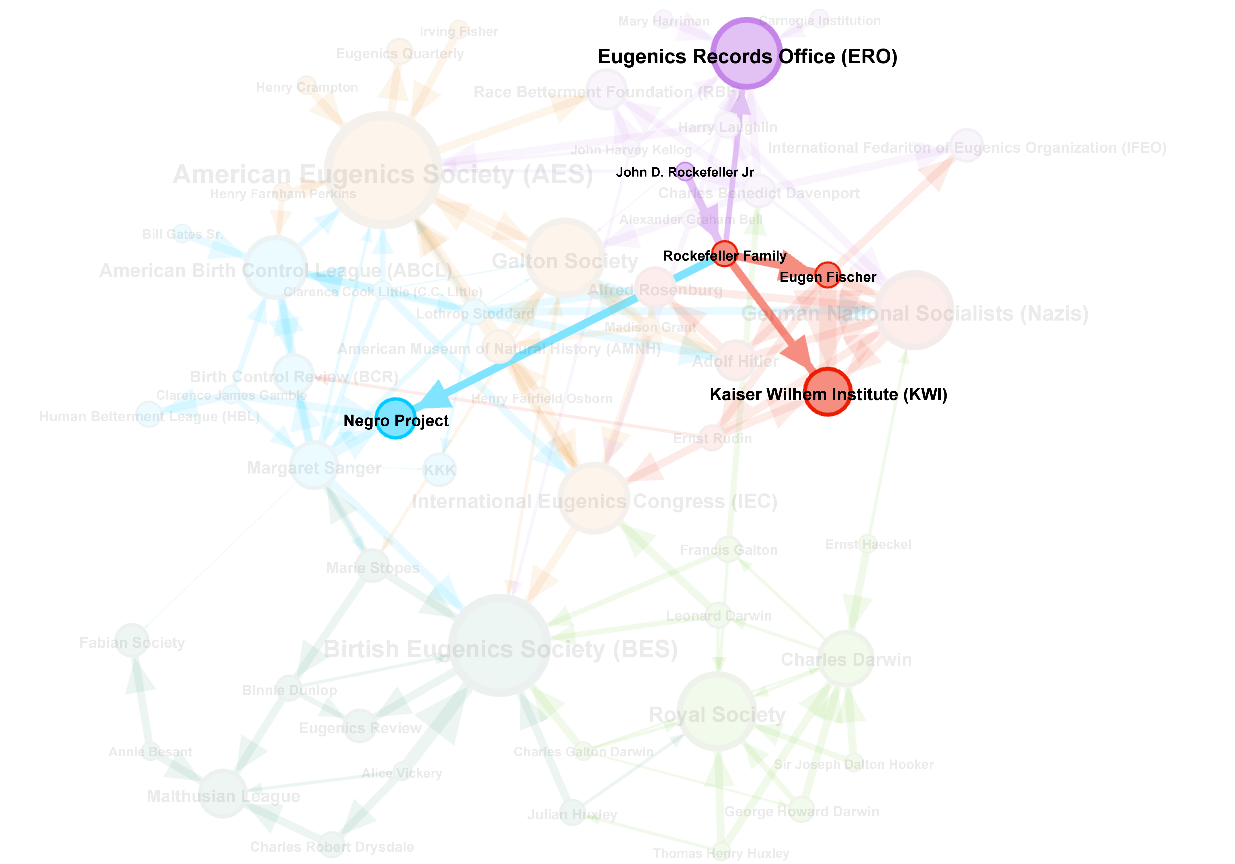
21st Century Legacy
Now that all the connections between all of these figures have been laid out its time to determine what the legacy of 20th century eugenics is. In this section I will try and answer the following questions…
-
Did the rebranding of the eugenics movement mark an essential change in the eugenics ideology?
-
Do we see eugenics today?
-
If we do where do we see it manifest?
To answer the first question we first have to define what eugenics is. The etymology is composed of the greek root “eu” meaning good and suffix “genos” meaning birth. In short, it is a set of beliefs and practices used to improve the genetic quality of mankind. While it seems that this belief has always existed in one form or another (proposed by Plato to form an ideal society in The Republic), it became a staple of scientific and progressive thought in the 20th century with the rapid acceptance of Darwinism as dogma. If a species can evolve, it implies that there are those organisms within that species that are “less evolved” and “more evolved”. If humanity as whole wants to progress as a species it must have more evolved individuals to reproduce more than the less evolved individuals (if you are a biologist reading this forgive me if it sounds like I am saying individual organisms evolve like Pokemon do. That is not my intention). By doing this humanity can move “forward” towards a better society by breeding future generations of humans who are smarter, taller, stronger, and overall better than the humans of the last. The only difference between racial eugenics and plain eugenics is the scope. The Nazis wanted to purge non “Aryan” people from their nation’s gene pool, and the eugenicists that inspired them wanted to purge “undesirables” from the human race’s gene pool. This forms the basic principle of eugenic thought.
When the eugenic organizations cast off the label of being “eugenic societies” and they adopted terms like “genetic”, “biodemographic”, and “biosocial”, did their beliefs fundamentally change? And did birth control and family planning advocates distance themselves from those eugenicists before that transition? Short answer is: no.
Even into the latter half of the 20th century, there was significant overlap between organizations that weren’t explicitly eugenic and those that were. For example, Alan Frank Guttmacher, the 2nd president of PP (1962-1968) after Sanger, was also the vice-president of AES in 1958. It is very likely that he shared Sanger’s view that society should do everything in their power to improve the human race by improving their genetic quality. As I had mentioned earlier, Clarence James Gamble himself founded a family planning organization called Pathfinder Fund in 1957. The British National Birth Control Committee (NBCC), later the Family Planning Association (FPA), was founded by Margaret Pyke, a member of the BES who in the post-WW2 era wrote several articles for both the Eugenics Quarterly in 1956 and the Eugenics Review in 1963 [24] [25]. The list of examples of cooperation between eugenicists and seemingly innocuous family planning institutions goes on. This is unsurprising if you consider that they agreed on an essential point; that the lower classes, primarily of inferior genetic stock, should have smaller families, and ideally should not have children at all.
The answer to the 2nd and 3rd question is that eugenics is part and parcel of Western society; in short we live in a eugenic society. Rather than dissipating after WW2, eugenics became more virulent and widespread to the point that Westerners no longer recognize the very beliefs they hold are in essence eugenic. However, like asymptomatic viruses, it is extremely subtle since it is rarely if ever explicitly racial, to which we are extremely sensitive..
To use an example from my own life, I remember watching the opening scene of Idiocracy, in which the higher-IQ couple, Trevor and Carol, continually pushed off having children and ended up with none while Clevon bred like a rabbits, and having thoughts quite in line with Margaret Sanger’s sentiments in her The Pivot of Civilization [21]
Surely it is an amazing and discouraging phenomenon that the very governments that have seen fit to interfere in practically every phase of the normal citizen’s life, dare not attempt to restrain, either by force or persuasion, the moron and the imbecile from producing his large family of feeble-minded offspring.
I was only a teenager in high school at the time, but I had such developed views on how a society should be run, and who should and should not be passing on their genetics. Where did such ideas come from? The education system and the culture. By default Westerners are initiated into a culture that is neutral if not outright supportive of euthanasia, designer babies (CRISPR), abortion, birth control etc. because the “eugenic religion” of Julian Huxley and Galton has become the foundation of our ethics. What is “good” for American society and, to a larger extent, the world is if poor people were to have smaller children! Frederick Osborn writes positively on the prospect of reducing birth rates in Issue 2 of the 1963 Eugenics Quarterly “The reduction [birth rates] would be greatest among those at the lowest educational level… The reduction would also be greatest among the large families at the lowest economic levels.”[26]. He also writes in The Future of Human Heredity that “Eugenic goals are most likely to be attained under a name other than eugenics.” [27], namely through voluntary means via birth control, contraceptives, and the like. It would also be good to stop having genetically defective children. If the fetus has genetic problems like Down Syndrome… you are better off aborting it. And isn’t it great that not only do we have technology that allows us to avoid genetic defects, we will soon be able to selectively choose which genes to include and to exclude in our children?
This biological and genetic telos is implicit in Western society. What is “good” is what will “progress” the human race to a more “evolved” state perhaps even to the point where we cease to be humans. This is the basic thesis of transhumanism, a philosophical movement that Julian Huxley also founded. The desire to achieve more “evolved” state or higher lifeform is nothing other than man’s desire to become perfect, and become god-like. This inverted form of theosis, the belief that man can become god-like through participation in God’s energies, in which perfection is achieved through matter rather than from spirit, is the religion of modernity.
The legacy of Darwinism and of its offspring, eugenics, is on that is profound and runs deep in the heart of the spirit of the West. The children that are fed this propaganda (a term Pyke to describe the very beliefs she holds) will have their beliefs shaped in a way that they will see the world in a eugenic lens, painting large swathes of the society as “defective” or “inferior” and wishing that they would either have less children or none at all, as if they were livestock to be culled. With each passing generation, more and more of society will have been initiated into this “eugenic religion”. My only hope is that we reject it.
Short notes on People/Organization (non-exhaustive and doesn’t include all the figures and organizations)
Rockefeller Foundation - Funded Negro Project, ERO, Human Betterment League (1947), KWI.
Thomas Henry Huxley ie Darwin’s Bulldog - X-Club, Royal Society, . Grandfather of Julian and Aldous Huxley.
Julian Huxley - Royal Society biologist, and president of BES from 1959-1962, founding member of WWF and UNESCO.
Clarence James Gamble - Grandson of founder of Proctor and Gamble. Director of ABCL (PP), President of Pennsylvania Birth Control Fedaration, state delegate, one of five vice-presidents, and member of the Executive Committee of the Board of the American Birth Control League; medical field director of Margaret Sanger’s Birth Control Clinical Research Bureau, partnered with Sanger for Negro Project, founder of Pathfinder Fund, and founding member of Human Betterment League of NC in 1947. He got a letter from Sanger “We do not want the word to go out that we want to exterminate the Negro population, and the minister is the man who can straighten that idea out if it ever occurs to any of their more rebellious members.”
Charles Darwin - Founder of Darwinism and evolutionary biology. He had two sons who were eugenicists Leonard Darwin and George Darwin.
Sir George Howard Darwin - English barrister and astronomer. Royal society fellow. Advocated for eugenics.
Leonard Darwin - English politician, economist and eugenicist who mentored Ronald Fischer, an evolutionary biologist, statistician and eugenicist. Chairman of BEC from 1911 to 1928, succeeding his half-cousin once removed Francis Galton. Leonard held the 1st Int. Congress of Eugenics. Royal Society fellow.
Charles Galton Darwin - Son of Sir George Howard Darwin and grandson of Charles Darwin and president of the Eugenics Society from 1953 to 1959, and, near the end of his life in the early 1960s, Advisory Editor of the still-published Mankind Quarterly. Royal Society Fellow.
Francis Galton - Coined the term eugenics, president from 1907-1911. He was inspired by his cousin Charles Darwin’s work. “In an effort to reach a wider audience, Galton worked on a novel entitled Kantsaywhere from May until December 1910. The novel described a utopia organised by a eugenic religion, designed to breed fitter and smarter humans.”
Charles Benedict Davenport - Cofounder of ERO@CSHL with Henry H Laughlin in 1910 and director there until 1934, and RBF with John Harvey Kellog and Fischer in 1906 . Also found International Federation of Eugenics Organizations (IFEO) in 1925, with Eugen Fischer as chairman of the Commission on Bastardization and Miscegenation (1927). Maintained connections to Nazi party even in 30s with Hitlers rise to power.
Harry Laughlin - Founder of AES with Madison Grant, Irving Fischer, Henry Fairfield Osborn, and Henry Crampton. President of AES from 1927-1929. Superintendent at ERO@CHSL which he founded with Davenport from 1910-1921. Advocate for compulsory sterilization. The Reichstag of Nazi Germany passed the Law for the Prevention of Hereditarily Diseased Offspring in 1933, closely based on Laughlin’s model.
Madison Grant - Author of The Passing of the Great Race. Founded AES with Laughlin, Fischer, Osborn, Crampton, vice president of the Immigration Restriction League, a founding member of the Galton Society with Davenport, and one of the eight members of the International Committee of Eugenics. Passing of the Great Race was lauded by Adolf Hitler, who in the early 1930s wrote a ‘fan letter’ to Grant in which he called the book “my Bible”.
John Harvey Kellog - Founded RBF based in Battle Creek MI with Davenport and Fisher. Helped fund ERO. Member of AES and BES.
Ernest Rudin - Wrote in Sangers Birth Control Review. Prominent Swiss-born German psychiatrist, geneticist, eugenicist and Nazi. He also argued for, designed, justified and funded the mass sterilization and clinical killing of adults and children.
Henry Farnham Perkins - AES President from 1931-1934 and worked with the ABCL.
Alexander Graham Bell - Organized the First International Conference on Eugenics (1912), and was honorary president of the Second Conference in 1921. He participated with the ERO as chairman on the board, and helped guide research carried out by the association
Clarence Cook Little - Spent three years at CSHL, found ABCL, President of AES in 1929. 1954-1969 Scientific Director for Tobacco Industry Research Committee.
Margaret Sanger - Founder of ABCL with Stoddard and Little, and Birth Control Review. Member of AES and BES.
Lothrop Stoddard - Founder of ABCL with Sanger and Little, and member of AES. Nazi and KKK. “The Nazi Party’s chief racial theorist Alfred Rosenberg got the racial term Untermensch from the German version of Stoddard’s 1922 book The Revolt Against Civilization: The Menace of the Under-man.” Met with Heinrich Himmler, Robert Ley and Fritz Sauckel, as well as a brief meeting with Hitler himself.
Frederick Osborne - Nephew of fellow eugenicist Henry Fairfield Osborne, and cousin of Henry Fairfield Osborn Jr. American philanthropist, military leader, and eugenicist who played an important role in rehabilitating eugenics post WW2. The American Philosophical Society said this about him in 1983 “the respectable face of eugenic research in the post-war period.” President of AES from 1946-1951 but was called to serve in the State Department.
Henry Fairfield Osborne - American paleontologist, geologist and eugenics advocate. President of American Museum of Natural History for 25 years. President of the Second International Congress of Eugenics which was held in New York in 1921, sponsored by the Eugenics Record Office and the American Museum of Natural History.
Alfred Rosenburg - Chief Nazi theorist and ideologue via his seminal work The Myth of the Twentieth Century, which took inspiration from Madison Grant, Lothrop Stoddard, Houston Stewart ChamberlainArthur de Gobineau. Known for his hatred of Christianity.
Annie Besant - Socialist, theosophist, women’s right activist, freemason, and secularist. Was involved in the founding of many anti-clerical and secular organizations like National Secular Society (NSS), Malthusian League, Fabian League. Close associates include Charles Bradlaugh (founder of NSS), Helen Blavatsky (founder of Theosophy) and George Bernard Shaw (Fabian Society member and writer).
Bibliography
[2] Darwin’s letter to Haeckel
[3] Darwin’s review of Hereditary Genius
[4] Memoir of Sir George Howard Darwin by his brother Francis Darwin. Page 19 of the pdf states that he wrote a “eugenic” article.
[5] Sir Charles Galton Darwin connections to eugenics
[6] Evolution in Action by Julian Huxley. Pages 171-172. See screenshot
[7] Cold Springs Harbor Labratory entry at Eugenics archive
[8] Eugenics Office Record entry at Eugenics archive
[9] The ERO entry @ The Embryo Project Encyclopedia
[10] American Eugenics Society entry @ The Embryo Project Encyclopedia
[11] Forced sterilization of Native American Women
[12] Forced Sterilization of Puero Rican women
[13] Huxley’s Bio on Gutenburg
[14] Expose on Charles Davenport
[15] Defending the Master Race - Conservation, Eugenics, and the Legacy of Madison Grant
[16] The Horrifying American Roots of Nazi Eugenics
[18] Sanger’s letter to Gamble
[19] Article on NC Sterilizations
[20] Article on Human Betterment League
[21] The Pivot of Civilization by Margaret Sanger - Chapter 4 for “Surely it is amazing…” and Chapter 8 for “Birth Control which has been criticized as negative and destructive, is really the greatest and most truly eugenic method”
[22] The Link between the Rockefeller Foundation and Racial Hygiene in Nazi Germany.
[23] Rockefellers and Roe v Wade
[24] Population planning by Margrate Pyke in Eugenics Quarterly Volume 3, 1956 - Issue 3
[25] Family Planning: An Assessment by Margaret Pyke in The Eugenics Review, July 1963, Volume 55, No.2
[26] Excess and unwanted fertility - Frederick Osborn in Eugenics Quarterly Volume 10, 1963 - Issue 2
[27] The Future of Human Heredity
Additional Reading
https://www.liveaction.org/news/black-woman-sterilized-eugenic-planned-parenthood/
https://www.theguardian.com/politics/from-the-archive-blog/2019/may/01/eugenics-founding-fathers-british-socialism-archive-1997
https://www.ncbi.nlm.nih.gov/pmc/articles/PMC2986354/?page=1 - Binnie Dunlop in Eugenics Review obituary
https://www.ncbi.nlm.nih.gov/pmc/articles/PMC4366572/- ‘Julian Huxley and the Continuity of Eugenics in Twentieth-century Britain’ by Professor Paul Weindling
https://www.usatoday.com/story/news/nation-now/2014/06/20/california-female-inmates-sterilized/11037129/ - California sterilizations in 2010s
https://www.ncbi.nlm.nih.gov/pmc/articles/PMC1682156/pdf/ajhg00061-0198.pdf - The Survival of Eugenics in 20th-Century Germany by Paul Weindling
Washington Herald Article An image of this is also available in the repository
Share